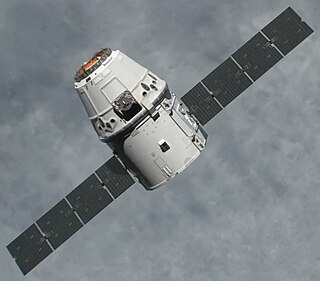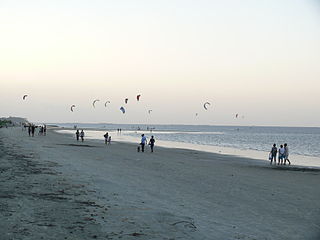
Arianespace SA is a multinational company founded in 1980 as the world's first commercial launch service provider. It undertakes the operation and marketing of the Ariane programme. The company offers a number of different launch vehicles: the heavy-lift Ariane 5 for dual launches to geostationary transfer orbit, the Soyuz-2 as a medium-lift alternative, and the solid-fueled Vega for lighter payloads.

In the context of spaceflight, a satellite is an artificial object which has been intentionally placed into orbit. Such objects are sometimes called artificial satellites to distinguish them from natural satellites such as Earth's Moon.

A spacecraft is a vehicle or machine designed to fly in outer space. Spacecraft are used for a variety of purposes, including communications, earth observation, meteorology, navigation, space colonization, planetary exploration, and transportation of humans and cargo. All spacecraft except single-stage-to-orbit vehicles cannot get into space on their own, and require a launch vehicle.

The Guiana Space Centre is a French and European spaceport to the northwest of Kourou in French Guiana, France. Operational since 1968, it is particularly suitable as a location for a spaceport. It fulfills the two major geographical requirements of such a site:

Delta IV is an expendable launch system in the Delta rocket family. The rocket's main components are designed by Boeing's Defense, Space & Security division and built in the United Launch Alliance (ULA) facility in Decatur, Alabama. Final assembly is completed at the launch site by ULA. The rocket was designed to launch payloads into orbit for the United States Air Force Evolved Expendable Launch Vehicle (EELV) program and for the commercial satellite business. The Delta IV is available in five versions: Medium, Medium+ (4,2), Medium+ (5,2), Medium+ (5,4), and Heavy, to cover a range of payload size and weight. The Delta IV was primarily designed to satisfy the needs of the U.S. military.

Small satellites, miniaturized satellites, or smallsats, are satellites of low mass and size, usually under 500 kg (1,100 lb). While all such satellites can be referred to as "small", different classifications are used to categorize them based on mass. Satellites can be built small to reduce the large economic cost of launch vehicles and the costs associated with construction. Miniature satellites, especially in large numbers, may be more useful than fewer, larger ones for some purposes – for example, gathering of scientific data and radio relay. Technical challenges in the construction of small satellites may include the lack of sufficient power storage or of room for a propulsion system.

The Korea Aerospace Research Institute (KARI) established in 1989, is the aeronautics and space agency of Republic of Korea(South Korea). Its main laboratories are located in Daejeon, in the Daedeok Science Town. KARI's vision is to continue building upon indigenous launch capabilities, strengthen national safety and public service, industrialize satellite information and applications technology, explore the moon, and develop environmentally-friendly and highly-efficient cutting-edge aircraft and core aerospace technology. Current projects include the KSLV-2 launcher. Past projects include the 1999 Arirang-1 satellite. The agency was founded in 1989. Prior to South Korea's entry into the IAE in 1992, it focused primarily on aerospace technology.
The Nimiq satellites are a Canadian fleet of geostationary telecommunications satellites owned by Telesat and used by satellite television providers including Bell TV and EchoStar. 'Nimiq' is an Inuit word used for an object or a force which binds things together. A contest in 1998 was held to choose the name of these satellites. The contest drew over 36,000 entries.
Several Asian countries have space programs and are actively competing to achieve scientific and technological advancements in space, a situation sometimes referred to as the Asian space race in the popular media as a reference to the earlier Space Race between the United States and the Soviet Union. Like the previous space race, issues involved in the current push to space include national security, which has spurred many countries to send artificial satellites as well as humans into Earth orbit and beyond. A number of Asian countries are seen as contenders in the ongoing race to be the pre-eminent power in space.
Orbcomm is a family of low Earth orbit communications satellites, operated by the American satellite communications company Orbcomm. As of July 2014, 51 such satellites have orbited Earth, with 50 still continuing to do so.
The DirecTV satellite fleet is a group of communications satellites located at various geostationary orbits for the DirecTV satellite television service and HughesNet internet service.

The year 2012 saw a number of significant events in spaceflight. In May and October, the first Commercial Orbital Transportation Services resupply missions took place, during which the SpaceX Dragon became the first private spacecraft to dock with the International Space Station (ISS). In June, China launched the manned Shenzhou 9 orbital mission, and North Korea achieved its first successful orbital launch in December. 2012 also saw China's first successful asteroid exploration mission, and the landing of NASA's Curiosity rover on Mars. The Vega and Unha-3 rockets made their maiden flights in 2012, while the Proton-K made its last.

PW-Sat is a series of satellites that includes the first Polish artificial satellite which was launched 13 February 2012 from ELA-1 at Guiana Space Centre aboard Italian-built Vega launch vehicle during its maiden voyage. PW-Sat1's mission was to test experimental elastic solar cells, as well as an orbital decay technology consisting of a "tail" designed to speed re-entry. It was expected to last for 1 year.
e-st@r is a miniaturised satellite built by the Politecnico di Torino. It is a 1-U CubeSat design weighing 1 kg.
VNREDSat-1 is the first optical Earth Observing satellite of Vietnam; its primary mission is to monitor and study the effects of climate change, predict and take measures to prevent natural disasters, and optimise the management of Vietnam's natural resources.

Göktürk-1 is a high resolution earth observation satellite designed and developed for the Turkish Ministry of National Defence by the Italian space service company Telespazio with technological input from Turkish Aerospace Industries (TUSAŞ) and Aselsan of Turkey.

ESTCube-1 is the first Estonian satellite and first satellite in the world to attempt to use an electric solar wind sail (E-sail). It was launched on 7 May 2013 aboard Vega VV02 carrier rocket and successfully deployed into orbit. The CubeSat standard for nanosatellites was followed during the engineering of ESTCube-1, resulting in a 10x10x11.35 cm cube, with a volume of 1 liter and a mass of 1.048 kg.
Vega flight VV01 is the maiden flight of the Vega launcher. It occurred from the Guiana Space Centre on 13 February 2012 at 10:00:00 UTC.













